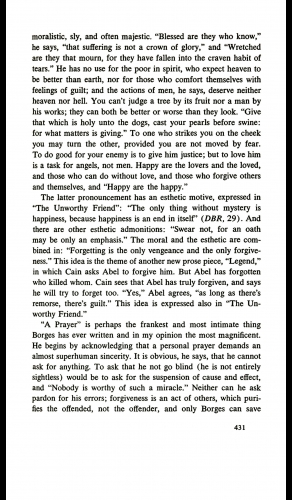Page 422 from Issue 25 The esthetic phenomenon Borges' objectivity, his blurring of faces, is directly related to his esthetic. I have suggested 15 that in his older fiction Borges carries his reader to a mythic awareness, an esthetic moment of n ...
Page not found
Page 423 from Issue 25 at us ingenuously from many of his new ones, and the forewords to the books he has published since 1960 are conspicuously con¬ cerned with the central point—the esthetic fact is not a collection of words on paper, but an experience: ...
Page 424 from Issue 25 verbal capture of a clear idea or feeling—the short-circuit that evaporates the pregnant myth. Borges points out in an essay on Nathaniel Hawthorne (Other Inquisitions) that Hawthorne's moralisms do not usually ruin his wor ...
Page 425 from Issue 25 and shows his own esthetic reaction. Salvadores was an Argentine who, as an opponent of the dictator Juan Manuel de Rosas (de¬ posed in 1852), was forced to hide in his cellar for nine years.19 This, plus the details, is his whole s ...
Page 426 from Issue 25 compared to the frustrated god "mentioned by Burton... [who] tried to create a bull and created a buffalo instead" (L, 155). It is the story told in Borges' poem "The Golem," where a rabb ...
Page 427 from Issue 25 olution and its aftermath. Transferred from the historical plane to the literary, San Martin's story is unconsummated and esthetic; but Bolivar's finished career (a completed "mental process") mak ...
Page 428 from Issue 25 the game and his army loses the battle; the chess game was a mere duplication of the larger reality. In the second, two famous bards have a contest of song. The first sings from dawn until dusk and hands the harp to the other. The l ...
Page 429 from Issue 25 narrator's house, he pauses to look at a patio tiled in black and white (an old image in Borges' work), prefiguring the parable of the chess game and perhaps suggesting that the events to fol¬ low will be a kind of ...
Page 430 from Issue 25 order and chaos—or, to use a term from Borges, order and ad¬ venture ("The Duel")—we might infer a contrast between the open, uncommitted, mythic-minded writer (Espinosa) and the closed-minded, compromised, or comm ...
Page 431 from Issue 25 moralistic, sly, and often majestic. "Blessed are they who know," he says, "that suffering is not a crown of glory," and "Wretched are they that mourn, for they have fallen into the crave ...











